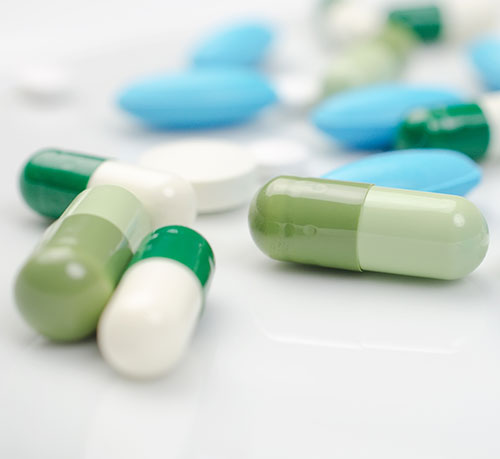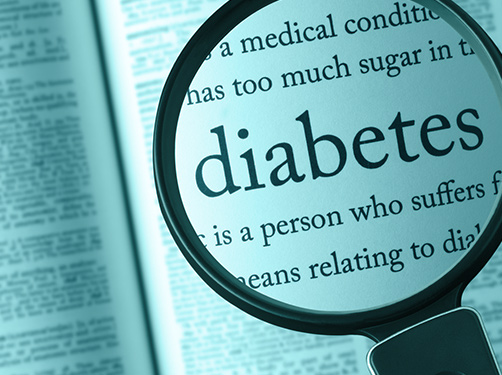Type 2 diabetes: Medications
Scientific support: Prof. Dr. Andreas Birkenfeld, Prof. Dr. Michael Roden, Dr. Theresia Sarabhai
More physical activity, a change in diet, and other lifestyle-related measures do not constitute adequate treatment for all people with type 2 diabetes. If this basic course of therapy does not succeed in bringing the metabolism back under control, the treating physician usually then prescribes medication to reduce the blood sugar (blood glucose) levels. This medication can be taken as tablets (oral antidiabetics) or be subcutaneously injected (for example, GLP-1 receptor agonists).
In the long term, high blood sugar levels can increase the risk of complications such as cardiovascular disease or diseases of the kidneys, eyes, and nerves. Admittedly, people with type 2 diabetes often have other risk factors, such as high blood pressure, elevated blood lipid levels, and being overweight, which may make a more tailored therapeutic approach necessary.
Based on the current valid guidelines, below, we offer general information relating to the treatment of diabetes mellitus. Please note that this information cannot replace medical consultation and does contain recommendations for individual types of therapy. Please discuss the individual therapeutic options with your doctor.

Work together to determine individual therapeutic goals
Not all people with diabetes respond well and sustainable to diabetes medication and it is not tolerated by all. Therefore, it is important that the treating physician together with the patient begins by determining individual therapeutic goals and discuss therapeutic options. These goals should be realistic and feasible for the patient in the everyday life.
Criteria that should be taken into consideration during the determination of the individual therapeutic goals include:
- The respective life circumstances and lifestyle of the patient,
- their age,
- potential mental or physical impairments,
- their overall state of health,
- personal values and previous experience, as well as the
- possible effects of the therapeutic measures on the patient’s quality of life.
Based on the jointly determined therapeutic goals, and the individual risk profile of the patient, based on the current state of research, two possible therapeutic strategies are available:
- Reducing the risk of the diabetes-induced accompanying illness and complications using the long-term blood sugar value (HbA1c) and an individually agreed target range.
- Reducing the risk of cardiovascular disease and/or kidney disease via the application of specific types of medication. For these blood sugar-reducing medications, risk-reducing effects on the onset and progression of cardiovascular and kidney diseases were proven in scientific studies.
Alongside the long-term objective of avoiding diabetes-associated accompanying illnesses and complications, drug-based therapy also aims to prevent the development of acute complications, such as low and high blood sugar levels. Furthermore, for people with type 2 diabetes, the effects of these medications on body weight should also be taken into account.
A further important aspect to be considered by the physician when determining the therapeutic strategy are the available so-called endpoint studies focusing on the individual active substances. Endpoint studies are randomized controlled studies that, for example, assess the efficacy of active substances. In its assessment of the active substances, the National Health Care Guidelines on Type 2 Diabetes (2021) refer to studies and meta-analyses with the following patient-relevant endpoints:
- Overall mortality rate
- Cardiovascular diseases (e.g., heart attack, heart failure (cardiac insufficiency) and the associated inpatient hospital stays, stroke)
- Kidney diseases (e.g., chronic kidney failure or permanent loss of renal function (terminal kidney failure), dialysis dependence)
- Other diseases (for example eye diseases (retinopathy), nerve disorders (neuropathy) and diabetic foot syndrome)
- Adverse drug effects (for example low blood sugar levels)
How do the various types of antidiabetic medications work?
There are various classes of active antidiabetic substances with different modes of action:
- Some drugs stimulate the production of insulin (sulfonylureas and glinides) and can therefore cause low blood sugar (hypoglycemia).
- Others increase the efficacy of the body's own insulin and have less risk of causing low blood sugar levels (metformin and glitazones).
- Or they enable the needs-required production of insulin for as long as blood sugar levels are elevated (DPP-4 inhibitors (gliptine) and GLP-1 receptor agonists (glutide)).
- There are others that increase the amount of sugar (glucose) released from the kidneys (SGLT-2 inhibitors (gliflozine)).
- Or they may delay the breakdown of carbohydrates in the intestinal tract, meaning that they are absorbed more slowly into the blood stream (alpha-glucosidase inhibitors).
What course does the drug-based treatment of type 2 diabetes take?
Non-drug-based therapy, known as basic therapy, provides the foundation for the treatment of type 2 diabetes. Basic therapy includes training, dietary adjustment, increasing physical activity and, when necessary, the patient must lose weight and stop smoking. Only when these measures are no longer deemed to be adequate to help achieve the individual therapeutic goals should drug-based therapy be initiated, according to the National Health Care Guideline on Type 2 Diabetes (2021).
Before beginning any therapy, the treating physician will provide the patient with detailed information regarding the advantages and disadvantages of the various therapeutic options. Alongside the individually set therapeutic goals, the patient's risk of cardiovascular disease and kidney disease will be taken into consideration.
Depending on whether there is no risk, an elevated risk, or a preexisting cardiovascular or kidney disease, a distinction is made between monotherapy (treatment with one type of medication) and therapy using a combination of different diabetes medications:
- For people with type 2 diabetes who are not at greater risk of developing cardiovascular disease, the National Health Care Guideline recommends monotherapy with metformin.
- If a patient already has cardiovascular or kidney disease (nephropathy), a combination of metformin and a SGLT-2 inhibitor or a GLP-1 receptor agonist can be beneficial.
- People with type 2 diabetes who have an increased risk of developing cardiovascular disease should, together with their doctor, assess the further therapeutic procedures while taking the individual therapeutic goals and the advantages and disadvantages of each therapy into account.
To enable assessment of the effects of a therapeutic measure, the National Health Care Guideline on Type 2 Diabetes (2021) recommends consistent application of the selected course of therapy for 3 to 6 months.
What types of blood sugar-reducing drugs are available?
Biguanide
This drug class includes substances like metformin
Metformin is a biguanide that continues to be recommended in the type 2 diabetes guidelines as a first-choice drug for cases with no increased risk of cardiovascular disease. The active substance reduces the release of sugar (glucose) from the liver and increases the insulin sensitivity in the cells. It can also promote a drop in LDL cholesterol levels and reduce appetite (according to studies with limited evidence). Metformin does not directly influence the release of insulin, meaning that monotherapy with metformin has a low-risk of resulting in low blood sugar levels (hypoglycemia). The substance can be combined with other antidiabetics and insulin.
The available endpoint studies point to metformin reducing the incidence of diabetes-associated cardiovascular disease as well as overall mortality rates (according to studies with limited evidence).
It is very common for patients to suffer gastrointestinal problems such as nausea, loss of appetite, stomach pains, vomiting, and diarrhea in the initial stages of treatment using metformin. There can also be changes in the way different tastes are perceived. This is why therapy begins using low a dosage, which is then increased gradually. The use of metformin is limited especially in the case of renal insufficiency. During therapy with metformin, the renal function must be assessed every 3 to 6 months. Metformin use should be discontinued if the estimated glomerular filtration rate (eGFR) is below 30 ml/min, according to the practice recommendation Therapy of Type 2 Diabetes (2020) from the German Diabetes Society.
Alpha-glucosidase inhibitors
This drug class includes substances such as acarbose and miglitol
Alpha-glucosidase inhibitors are taken at mealtimes and help delay the breakdown of carbohydrates by inhibiting the intestinal enzymes responsible for splitting carbohydrates into simple sugars. The sugar (glucose) is then absorbed more slowly into the bloodstream, reducing the elevated blood sugar levels, especially after meals (postprandial hyperglycemia). However, they have a limited effect on blood sugar levels and are now rarely used in the treatment of diabetes.
When administered as a monotherapy, alpha-glucosidase inhibitors do not cause low blood sugar or result in weight gain. The typical side effects include flatulence, gastrointestinal problems, and diarrhea. An increase in liver enzyme levels may also occur. A gradual dosage increase during the initial stage of therapy with alpha-glucosidase inhibitors can help limit any gastrointestinal problems.
Glitazones/Thiazolidinediones
This drug class includes substances like pioglitazone
Glitazones (e.g., thiazolidinediones such as pioglitazone) improve the insulin sensitivity of fatty tissue, the liver, and muscles. and correspondingly glucose uptake, while reducing both the fasting and post-meal blood sugar levels.
Typical side effects associated with this drug class include an increase in fatty tissue, upper respiratory tract infections, water retention, and visual impairments (usually in the early stages of the therapy as a result of blood sugar level fluctuations), and an elevated risk of osteoporosis and bone fractures. Due to the side effects, glitazones are used only in exceptional cases in the treatment of type 2 diabetes.
The available endpoint studies point to a potential risk reduction for the onset of cardiovascular disease related to pioglitazone (according to studies with limited evidence).
Sulfonylureas
This drug class includes substances such as glibenclamide, glimepiride, gliclazide and gliquidone
Sulfonylureas work by stimulating the release of insulin from the pancreas. Because this effect is triggered regardless of the current blood sugar level, the risk of low blood sugar is increased. The drop in blood sugar can be further exacerbated due to interactions with numerous other types of medications (for example, aspirin, and other painkillers, and anti-clotting agents).
All previous endpoint studies state that sulfonylureas can prevent diabetes-induced complications affecting the eyes (retinopathy), kidneys (nephropathy), nerves (neuropathy), and feet (diabetic foot syndrome) (according to studies with limited evidence).
When used over an extended period of time, the effectiveness of sulfonylureas in the treatment of type 2 diabetes begins to decrease, and there is normally weight gain during therapy using sulfonylureas. Other typical side effects include gastrointestinal problems.
Glinides
This drug class includes substances such as repaglinide and nateglinide
Similar to sulfonylureas, glinides also increase the body's production and release of insulin in the pancreas regardless of the current blood sugar level. In contrast to sulfonylureas, they are fast acting with the effects lasting only a short time. This means that the risk of low blood sugar still exists but is greatly reduced. Glinides are taken before mealtimes and can help reduce blood sugar increases caused by food intake. For people who eat at irregular intervals, thanks to the short duration of their effects compared with sulfonylureas, they can be applied with more flexibility.
Glinides - similar to sulfonylureas - can also lead to weight gain and gastrointestinal problems, such as stomach pain, nausea, and diarrhea.
Due to the lack of evidence regarding their therapeutic benefit, glinides are nowadays used only in justified and exceptional situations in the treatment of type 2 diabetes.
DPP-4 inhibitors (Gliptine)
This drug class includes substances such as saxagliptin, sitagliptin, vildagliptin, and linagliptin
DPP-4 (dipeptidyl peptidase-4) inhibitors (gliptins) inhibit the DPP-4 enzyme in the blood. This means that certain intestinal hormones responsible for insulin release are broken down more slowly in the blood. The post-meal blood sugar level is reduced but the fasting level is not. They also reduce the production of sugar in the liver. Monotherapy is associated with a low risk of low blood sugar levels. Furthermore, neither weight gain nor reduced effectiveness associated with long-term use have been reported. The available endpoint studies have not yet been able to demonstrate whether they can prevent diabetes-associated accompanying illnesses and complications.
DPP-4 inhibitors can be taken in combination with other antidiabetics and fixed-dose combinations (for example, metformin and sitagliptin in one tablet) are available.
Examples of typical side effects include upper respiratory tract and urinary tract infections, gastrointestinal problems, symptoms of exhaustion, skin rashes, headaches, dizziness, and inflammation of the paranasal sinuses, gastrointestinal tract, and/or pancreas.
SGLT-2 inhibitors (Glifozines)
This drug class includes substances such as dapagliflozin, empagliflozin, ertugliflozin and canagliflozin
SGLT-2 (sodium dependent glucose co-transporter 2) inhibitors (glifozines) reduce blood sugar levels by blocking the SGLT-2 enzyme in the kidney. Without this enzyme, less sugar (glucose) is transferred from the kidneys back into the bloodstream and more glucose is excreted in the urine via the kidneys. The blood sugar level drops.
This excretion of excess calories results in weight loss. Blood pressure can also drop. Several endpoint studies have shown that some SGLT-2 medications positively influence the progression of kidney diseases (nephropathy) and heart failure and help prevent early death as well as reducing the risk of heart attacks and death in type 2 diabetes patients with preexisting cardiovascular conditions (moderate to high level of evidence).
When administered as a monotherapy, SGLT-2 inhibitors do not increase the risk of low blood sugar. Potential side effects include urinary tract and genital infections, fluid loss, skin rashes, and itching, dizziness, constipation and/or nausea, increased thirst and/or urinary urgency, as well as diabetic ketoacidosis.
GLP-1 receptor agonists
This drug class includes dulaglutide, exenatide, liraglutide, semaglutide, lixisenatide and albiglutide
GLP-1 stands for glucagon-like peptide-1 and refers to a protein that belongs to the gastrointestinal group of hormones. GLP-1 is released as a reaction to food intake and is involved in the control of the sugar metabolism: It promotes the release of insulin from the pancreas while simultaneously inhibiting the hormone glucagon - which has the opposite effect to insulin. GLP-1 receptor agonists (glutides) simulate the effects of the gastrointestinal hormone GLP-1. They also cause an early onset of the sensation of being full and result in weight loss.
In contrast to the above-listed drug classes, the majority of GLP-1 receptor agonists still have to be injected subcutaneously, i.e., into the subcutaneous fatty tissue. Patient can self-inject 1 or 2 times daily or once a week. The active substance semaglutide in tablet form was approved in Europe in April 2020.
In particular, these substances result in weight loss. Current endpoint studies show that some GLP-1 receptor agonists also reduce the risk of cardiovascular and kidney disease (nephropathy) as well as reducing the premature mortality rate – especially in persons with preexisting heart disease (moderate to high evidence level).
Gastrointestinal problems, such as nausea and a feeling of fullness, are common and often subside as therapy continues. Typical side effects include skin rashes, headaches, dizziness, fatigue, inflammation of the nose, throat and/or gallbladder, elevated enzyme levels, increased heart rate and/or arrhythmia.
Sources:
Bundesärztekammer et al.: Nationale Versorgungsleitlinie Typ-2-Diabetes. Teilpublikation der Langfassung. 2. Auflage. Version 1. 2021
Bundesärztekammer et al.: Patientenleitlinie zur Nationalen Versorgungsleitlinie Therapie des Typ-2-Diabetes. 1. Auflage. Version 1. 2015
Bundesärztekammer et al.: Nationale Versorgungsleitlinie Therapie des Typ-2-Diabetes. Langfassung. 1. Auflage. Version 4. 2014 (Gültigkeit abgelaufen)
Clodi, M. et al.: Antihyperglykämische Therapie bei Diabetes mellitus Typ 2 (Update 2019). In: Wien Klin Wochenschr, 2019, 131: 27-38
Deutsche Diabetes Gesellschaft: Stellungnahme zu Repaglinid. 2016 (Letzter Abruf: 15.11.2019)
Gemeinsamer Bundesausschuss: G-BA setzt Verordnungseinschränkung für Glinide in Kraft. (Letzter Abruf: 31.05.2021)
Gemeinsamer Bundesausschuss: G-BA schließt Glinide und Glitazone zur Diabetes-Therapie von der Verordnungsfähigkeit zu Lasten der GKV aus. (Letzter Abruf: 31.05.2021)
Gerstein, H. C. et al.: Dulaglutide and cardiovascular outcomes in type 2 diabetes (REWIND): A double-blind, randomised placebo-controlled trial. In: Lancet, 2019, 394: 121-130
Husain, M. et al.: Oral Semaglutide and Cardiovascular Outcomes in Patients with Type 2 Diabetes. In: N Engl J Med, 2019, 381: 841-851
Inzucchi, S. E. et al.: Management of hyperglycaemia in type 2 diabetes: a patient-centered approach. Position statement of the American Diabetes Association (ADA) and the European Association for the Study of Diabetes (EASD). In: Diabetologia, 2012, 55: 1577-1596
Landgraf, R. et al.: Therapie des Typ-2-Diabetes. In: Diabetologie, 2020, 15: S65-S92
Marso, S. P. et al.: Liraglutide and Cardiovascular Outcomes in Type 2 Diabetes. In: N Engl J Med, 2016, 375: 311-322
Marso, S. P. et al.: Semaglutide and Cardiovascular Outcomes in Patients with Type 2 Diabetes. In: N Engl J Med, 2016, 375: 1834-1844
Patel, A. et al.: Intensive blood glucose control and vascular outcomes in patients with type 2 diabetes. In: N Engl J Med, 2008, 358: 2560-2572
Pfeiffer, A. F. H. et al.: The Treatment of Type 2 Diabetes. In: Dtsch Arztebl Int, 2014, 111: 69-82
UK Prospective Diabetes Study (UKPDS) Group: Effect of intensive blood-glucose control with metformin on complications in overweight patients with type 2 diabetes (UKPDS 34). In: Lancet, 1998, 352: 854-865
UK Prospective Diabetes Study (UKPDS) Group: Intensive blood-glucose control with sulphonylureas or insulin compared with conventional treatment and risk of complications in patients with type 2 diabetes (UKPDS 33). In: Lancet, 1998, 352: 837-853
Wanner, C. et al.: Empagliflozin and Progression of Kidney Disease in Type 2 Diabetes. In: N Engl J Med, 2016, 375: 323-334
Wiviott, S. D. et al.: Dapagliflozin and Cardiovascular Outcomes in Type 2 Diabetes. In: N Engl J Med, 2018, 380: 347-357
Xu, T. et al.: Effects of Metformin on Metabolite Profiles and LDL Cholesterol in Patients with Type 2 Diabetes. In: Diabetes Care, 2015, 38: 1858-1867
Zinman, B. et al.: Empagliflozin, Cardiovascular Outcomes, and Mortality in Type 2 Diabetes. in: N Engl J Med, 2015, 373: 2117-2128
As of: 26.07.2021







